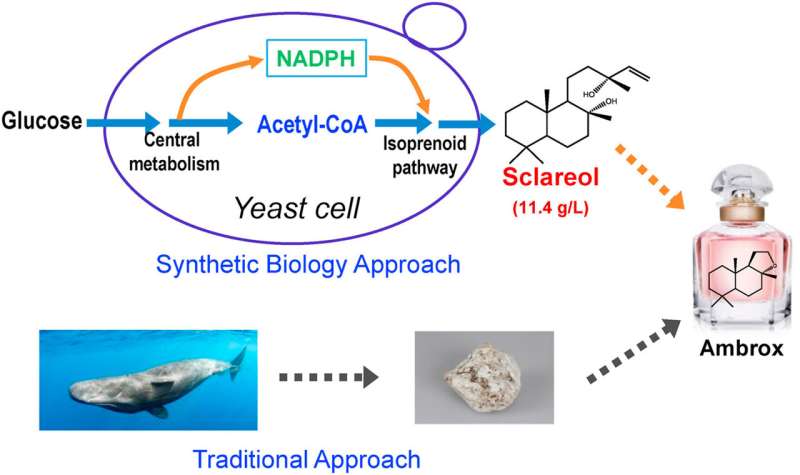Engineering yeast for sustainable production of sclareol, a precursor for synthetic of fragrance molecules Ambrox. Systematically engineering yeast cellular metabolism for enhancing supply of precursor acetyl-CoA and cofactor NADPH, and driving the metabolic flux of isoprenoid pathway, enabled overproduction of sclareol (11.4 g/L). Credit: Metabolic Engineering (2022). DOI: 10.1016/j.ymben.2022.11.002
Sclareol, a precursor for synthesis of fragrant chemical compound Ambrox, is traditionally extracted from the flowers and leaves of Salvia sclarea. However, it requires laborious and cost-intensive purification procedures due to the low concentration of sclareol in complex mixtures.
Recently, a research group led by Prof. Zhou Yongjin from the Dalian Institute of Chemical Physics (DICP) of the Chinese Academy of Sciences (CAS) has established a synthetic biology approach for diterpenoid production. They systematically engineered the brewing yeast Saccharomyces cerevisiae to produce sclareol.
This study was published in Metabolic Engineering on Nov. 9.
The researchers systematically engineered brewing yeast Saccharomyces cerevisiae for overproduction of sclareol by engineering isoprenoid biosynthetic pathways. This rewired its central metabolism and enhanced supply of precursor and cofactor.
For convenient manipulation, they developed a metabolic transforming strategy to transform a fatty-overproducing strain Y&Z036 toward sclareol overproduction at a modular manner, which facilitated the construction of versatile cell factories.
"Transcriptome and metabolic flux analysis showed that the global metabolic rewiring improved diterpenoid biosynthesis. Our strategy may improve the production of other acetyl-CoA-derived molecules," said Prof. Zhou.
More information: Xuan Cao et al, Engineering yeast for high-level production of diterpenoid sclareol, Metabolic Engineering (2022). DOI: 10.1016/j.ymben.2022.11.002
Provided by Chinese Academy of Sciences
























